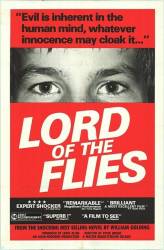Jack: We've got to have rules and obey them. After all, we're not savages. We're English! And the English are best at everything.
Ralph: His name's not Fatty. It's Piggy.
Ralph: You're a beast, and a swine, and a bloody, bloody thief.

Directed by: Peter Brook
Starring: Hugh Edwards, James Aubrey, Roger Elwin, Tom Chapin
Jack: We've got to have rules and obey them. After all, we're not savages. We're English! And the English are best at everything.
Ralph: His name's not Fatty. It's Piggy.
Ralph: You're a beast, and a swine, and a bloody, bloody thief.
Audio problem: When Jack says "Anyway, the conch doesn't count on this side of the island", he is clearly biting his banana and eating it, however the dialouge is heard perfectly clear, even though he is eating.
Trivia: The attempt to make the locations look wild and uninhabited were obviously not altogether successful. Near the beginning of the movie, some boys are sitting in a sandy clearing in public-school blazers. On the right of the screen you can clearly see a tent peg with ANTONY M written on it. Also, as one of Jack's choirboy-hunters thrashes through the undergrowth, look closely and you can see that he accidentally impales an old beer can.
Question: One of the boys, called Piggy, wears glasses. Piggy's glasses become an important, prized object, because the boys can use the lenses to refract the sun's rays, and thus start fires. It is fairly well established, that, on a hot day, in bright sunshine, one can focus the sun's rays through a magnifying glass to set light to combustible material. (I've done it myself, although it took me rather longer than the book or film suggested, and it only made a very small flame.) But could you use spectacles, that people wear to correct defective vision, to start a fire in this way? Surely, if this was possible, wouldn't it mean that when people who wear glasses went out in hot sunny weather, then they would burn their eyes?
Answer: Only convex magnifying lenses can be used to focus the sun's rays in such a way as to start a fire. A convex magnifying lens is bowed outwards on both sides. Such lenses are found in magnifying glasses, binoculars and cameras, for examples. Conventional spectacles to correct vision are convex on one side and concave (bowed inward) on the other side, and so cannot be used to start fires. If Piggy's glasses are used to start fires, then he is wearing convex magnifying lenses (which would only be useful for up-close reading purposes, and they would be utterly useless for any other vision correction) ; and, if indeed he is wearing truly convex magnifying lenses for some reason, then his retinas could certainly be damaged by even glancing at the sun.
Answer: Lenses for nearsightedness would not work, but they could be corrected for the purpose by filling their concave areas with clear water, which would make the whole object correctly refract sunlight.
That's a reported "survival" trick (placing a drop of clear water in the center of a concave lens so as to focus the sun's rays) ; but I've never had any success with it.
Separate from membership, this is to get updates about mistakes in recent releases. Addresses are not passed on to any third party, and are used solely for direct communication from this site. You can unsubscribe at any time.
Check out the mistake & trivia books, on Kindle and in paperback.
Answer: The key factor there is the focus of the light over distance. The light coming through the glass is refracted and focused on a single point. But it's bent like a ribbon. There is a "sweet spot" so to say where you have to hold the magnifying glass or lens at just the right distance and angle from the object to focus the center point of the light on it. Typically, this means holding the glass out a good several inches or even a foot or so away from what you wish to ignite to get the focal point of the light on it. Someone wearing glasses has them pretty much right up to their face. And so the light can't reach a focal point. Also keep in mind that for focusing the light through a lens, it needs to be angled just right for the light to go through it at the optimal angle and focus. Usually this means facing the sun directly. Typically people don't look up directly at the sun, at least not for more than a second. Especially with glasses on.
Quantom X ★